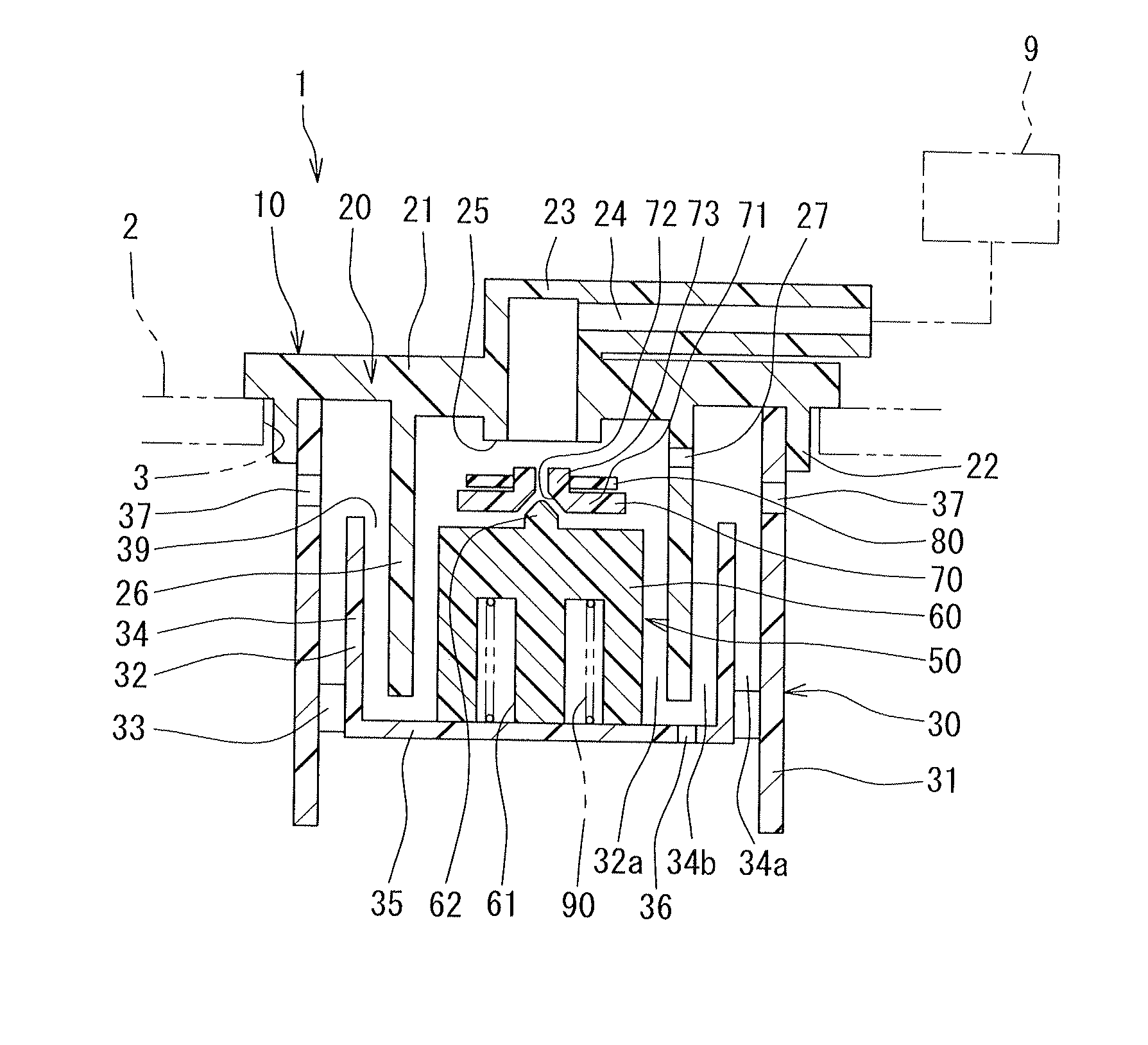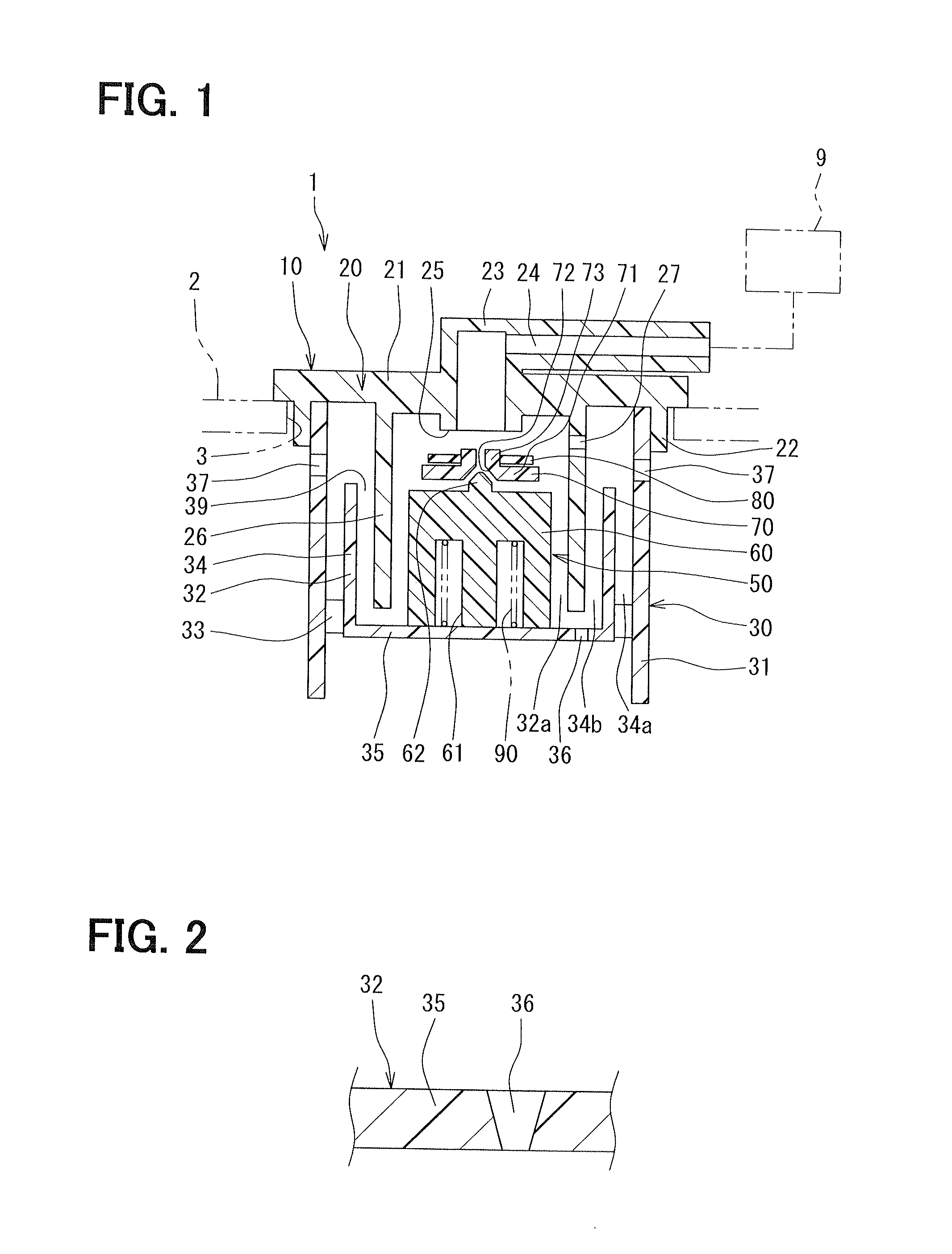Fill-up control valve device
a control valve and valve body technology, applied in the direction of valve operating means/releasing devices, mechanical equipment, transportation and packaging, etc., can solve the problems of increasing the pressure in the casing and the fuel tank, and the possibility of additional fuel feed, etc., to achieve stable time duration, easy structure, and easy stabilization
- Summary
- Abstract
- Description
- Claims
- Application Information
AI Technical Summary
Benefits of technology
Problems solved by technology
Method used
Image
Examples
first embodiment
[0050]FIG. 1 is a schematic cross-sectional view showing an outlined structure of a fill-up control valve device 1 according to a first embodiment, to which the present invention is applied. And FIG. 2 is a schematic cross sectional view showing a relevant portion of a vessel portion 32 of the fill-up control valve device 1.
[0051]As shown in FIG. 1, the fill-up control valve device 1 is attached to an opening 3 formed at an upper side wall of a fuel tank 2, which is for example mounted to a vehicle. The fill-up control valve device 1 is a valve device for opening and / or closing a ventilation passage 24, which connects an inside space of the fuel tank with a canister 9 located at an outside of the fuel tank 2, so that the fuel tank 2 is operatively communicated to the canister 9 depending on a liquid surface level (a liquid surface position) of liquid fuel in the fuel tank 2.
[0052]As shown in FIG. 1, the fill-up control valve device 1 is composed of a casing 10 and a float valve unit...
second embodiment
[0086]A second embodiment of the present invention will be explained with reference to FIG. 4.
[0087]The second embodiment differs from the first embodiment in a structure of the fuel drain through-hole formed at the closed end bottom of the vessel portion 32. The same reference numerals to the first embodiment are used in the second embodiment for designating the same or similar parts to the first embodiment.
[0088]As shown in FIG. 4, according to the present embodiment, a fuel drain through-hole 136, having a small diameter, is formed at the closed end bottom 35 of the vessel portion 32, so that the through-hole 136 passes through the closed end bottom 35 in the vertical direction. An inner peripheral surface of the fuel drain through-hole 136 is a cylindrical surface, so that a cross sectional area of the through-hole 136 has the same value from its upper end to a lower end. As in the same manner to the first embodiment, the cross sectional area of the through-hole 136 is made to b...
third embodiment
[0091]A third embodiment of the present invention will be explained with reference to FIGS. 5 to 9.
[0092]The third embodiment differs from the first embodiment in that a fuel pooling tank, into which the liquid fuel flows from the vessel portion 32, is provided. The same reference numerals to the first embodiment are used in the third embodiment for designating the same or similar parts to the first embodiment.
[0093]As shown in FIG. 5, the fill-up control valve device 1 is fixed to the ceiling portion of the fuel tank 2 of the vehicle, and a fuel pooling portion 230 (corresponding to the fuel pooling tank) is formed at a lower side of the vessel portion 32 of the casing 10.
[0094]An annular extending portion 234 is provided at the lower casing part 30 of the casing 10 in such a manner that the annular extending portion 234 extends in the downward direction from an outer periphery of the closed end bottom 35 of the vessel portion 32. The annular extending portion 234 is integrally for...
PUM
 Login to View More
Login to View More Abstract
Description
Claims
Application Information
 Login to View More
Login to View More - R&D
- Intellectual Property
- Life Sciences
- Materials
- Tech Scout
- Unparalleled Data Quality
- Higher Quality Content
- 60% Fewer Hallucinations
Browse by: Latest US Patents, China's latest patents, Technical Efficacy Thesaurus, Application Domain, Technology Topic, Popular Technical Reports.
© 2025 PatSnap. All rights reserved.Legal|Privacy policy|Modern Slavery Act Transparency Statement|Sitemap|About US| Contact US: help@patsnap.com



